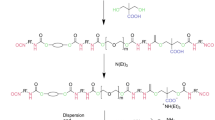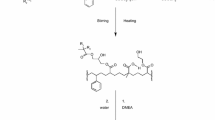Abstract
Polyurethane dispersions (PUDs) are one such class of coatings that comply well with stringent VOC regulations. In this study, PUDs were prepared as aqueous dispersions using a new highly versatile crosslinkable anionomer, 2-acrylamido 2 methylpropanesulfonic acid (ATBS), which is commercially available, yet not explored by the coating industry. The influence of this novel anionomer on the performance properties of polyurethane resins was evaluated by comparing performance/properties of this newly synthesized PUD with dispersion based on conventional anionomer, DMPA. Analyses of their physico-chemical and thermo-mechanical properties revealed that PUD based on ATBS showed comparatively much better thermal, mechanical, and chemical and coating properties than the PUD based on DMPA anionomer.










Similar content being viewed by others
References
Hourston, D.J., Williams G., Satguru R., Padget J.D., Pears D., “A Structure-Property Study of IPDI-Based Polyurethane Anionomers,” J. Appl. Polym. Sci., 67, 1437-1448 (1998). doi:10.1002/(SICI)1097-4628(19980222)67:8<1437::AID-APP9>3.0.CO;2-F.
KrÓl, P., KrÓl, B., Holler, P., Telitsyna, N., “ Polyurethane anionomers synthesised with aromatic, aliphatic or cycloaliphatic diisocyanates, polyoxyethylene glycol and 2,2-bis (hydroxymethyl)propionic acid. Part I. Synthesis and macro-molecular structure”, Coll. Polym. Sci., 284, 1107-1120 (2006). doi:10.1007/s00396-006-1487-6.
Lee, H-T., Wang, C-C. Synthesis and properties of aqueous polyurethane/polytert-butacrylate hybrid dispersions. J. Polym. Res., 12, 271-277. (2005) doi:10.1007/s10965-004-4823-x.
Kim, B.K., Lee, J.C., “ Modification of Waterborne Polyurethanes by Acrylate Incarporations”, J. Appl. Polym. Sci., 58, 1117-1124 (1995). doi:10.1002/app.1995.070580705.
Chen, S., Chen, L., “ Structure and properties of polyurethane/polyacrylate latex interpenetrating networks hybrid emulsions”, Coll. Polym. Sci., 282, 14-20 (2003). doi:10.1007/s00396-003-0863-8.
Saimani, S., Tharanikkarasu, K., Radhakrishnan, G., “ Aqueous Dispersions of Polyurethane Polyacrylic Acid Multiblock Copolymers Through Living Radical Polymerization”, J. Appl. Polym. Sci., 87, 1109-1115 (2003). doi:10.1002/app.11560.
Lee, J.S., Shin, J.H., Kim, B.K., Kang, Y.S., “Modification of aqueous polyurethanes by forming latex interpenetrating polymer networks with polystyrene”, Coll. Polym. Sci., 279, 959-965 (2001). doi:10.1007/s003960100522.
Rosa, F., Bordado, J., Casquilho, M., “ Hydrosoluble Copolymers of Acrylamide-(2-acrylamido-2-methylpropanesulfonic acid). Synthesis and Characterization by Spectroscopy and viscometry”, J. Appl. Polym. Sci., 87, 192-198 (2003). doi:10.1002/app.11325.
Zhang, C., Easteal, A. J., “Study of Free-Radical Copolymerization of N-Isopropylacrylamide with 2-Acrylamido-2-methyl-1-propanesulfonic Acid”, J. Appl. Polym. Sci., 88, 2563-2569 (2003). doi:10.1002/app.12095.
Denaro, A.R., Jayson, G.G., Fundamentals of Radiation Chemistry, Butterwirth, London, 1972.
Aggour,Y.,”Homogeneous Graft Copolymerisation of 2-Acrylamido-2-methylpropanesulphonic Acid onto Ethyl Cellulose”, J. Polym. Mater., 16, 1-6 (1999).
Kim, B.S., Kim, B.K., “ Enhancement of Hydrolytic Stability and Adhesion of Waterborne Polyurethanes”, J. Appl. Polym. Sci., 97, 1961-1969 (2005) doi:10.1002/app.21984.
Athawale, V. D., Peshane, S N., Waterborne PUR-dispersions: An approach to fine-tune the surface and bulk mechanical properties. European Coatings Journal., 1-2, 45-61 (2002).
David D. J., Staley H. B., Analytical Chemistry of Polyurethanes, High Polymer Science Series. Wiley-interscience, New York (1969).
Price, GF, “Techniques of End-Group Analysis.” In: Allen, PW (ed.) Techniques of Polymer Characterization, Chapter 7, p. 207. Butterworth, London (1959)
Zhang, C., Easteal, A. J. Study of Poly(acrylamide-co-2-acrylamido-2-methylpropane sulfonic acid) Hydrogels Made using Gamma Radiation Initiation. J. Appl. Polym. Sci., 89, 1322-1330 (2003). doi:10.1002/app.12246.
Visser, S.A., Cooper, S.L. Comparison of the Physical Properties of Carboxylated and Sulfonated Model Polyurethane Ionomers. Macromolecules, 24, 2576-2583 (1991). doi:10.1021/ma00009a067.
Author information
Authors and Affiliations
Corresponding author
Rights and permissions
About this article
Cite this article
Athawale, V.D., Kulkarni, M.A. Synthesis, characterization, and comparison of polyurethane dispersions based on highly versatile anionomer, ATBS, and conventional DMPA. J Coat Technol Res 7, 189–199 (2010). https://doi.org/10.1007/s11998-009-9184-2
Received:
Accepted:
Published:
Issue Date:
DOI: https://doi.org/10.1007/s11998-009-9184-2




